You are using an out of date browser. It may not display this or other websites correctly.
You should upgrade or use an alternative browser.
You should upgrade or use an alternative browser.
V-22 Osprey Thread - News, Pics, Videos
- Thread starter TerraN_EmpirE
- Start date
TerraN_EmpirE
Tyrant King
V-22 crash off Australian coast possibly due to downwash
- 23 MAY, 2018
- SOURCE: FLIGHTGLOBAL.COM
- BY: GARRETT REIM
- LOS ANGELES
An US Marine Corps investigation of the crash of a MV-22B Osprey into an amphibious transport ship in August 2017, which killed three, found that the rotorcraft suffered no mechanical or electrical problems and the flight crew was not at fault.
A paragraph containing the service’s "most probable" explanation of the mishap was redacted in the report, though engineers with Naval Air Systems Command noted problems with the aircraft’s rotor downwash in a non-redacted section.
The heavily redacted report offered few other clues as to what caused the tiltrotor aircraft to strike against the side of the USS Wisconsin off the eastern coast of Australia last year. The aircraft rapidly lost altitude on its approach for landing on the ship’s deck, hit the vessel's side and fell into the Pacific Ocean, resulting in the deaths of three and injuries to 23 others on board.
The MV-22B Osprey was participating in a training mission, simulating the evacuation of a US embassy in Raspberry Creek, Queensland, Australia.
While withholding an official explanation for the mishap, engineers with NAVAIR “discovered the presence of recirculated downwash reflecting off the hull of the ship and back into the rotor arc."
The report seemed to indicate that problems with downwash caused a thrust deficit, which caused a 200 ft/min to 300 ft/min (61m/min to 91m/min) rate of descent seconds before the MV-22B Osprey’s left nacelle, which houses its turboshaft engine, hit the flight deck.
The aircraft mishap had similarities to another accident in 2015, when a MV-22B Osprey crash landed onto the deck of the amphibious transport ship USS New Orleans, according to the investigation. Both aircraft had similar gross weights and experienced recirculating downwash off the reflecting off the hull of the ship.
The MV-22B Osprey pilot in the USS New Orleans accident was faulted for underestimating how much weight his aircraft was carrying, according to a USMC investigation of that incident.
The USMC publicly placed no blame or pointed to any cause in the most recent MV-22B mishap, instead emphasizing that the peace-time training exercise was difficult to perform.
“The mission was complex, challenging, and included flying into and out of a highly congested operational area. Executing this mission required a detailed plan and superior technical performance,” Maj Gen Thomas Weidley, 1st Marine Aircraft Wing commanding general, wrote in an endorsement of the report. “The Marines manning the mishap aircraft were mission capable, fully-trained, and qualified. The mishap aircraft was mechanically sound.”
According to the report, the mishap occurred in daytime with light winds, and no pitch or roll in the USS Wisconsin. Prior to the accident, the aircraft crew reported nothing out of the ordinary, an account which was backed up by the recovered flight data.
Jura The idiot
General
Jura The idiot
General
kinda cool:
The Military Still Wants a Belly Gun for the V-22 Osprey
The Military Still Wants a Belly Gun for the V-22 Osprey
For years, officials have wanted a forward firing gun under the Bell-Boeing 's belly to give it extra defensive measures when landing in an enemy hot zone.
But the rumored addition is still not a done deal, according to Bell-Boeing officials.
"There are some studies and development programs underway for an advanced firing weapon and electronic weapons packages," Chris Gehler, vice president and program director for the V-22 at Bell, told Military.com on Tuesday. [But] the "forward-firing weapon is not [coming] within the next several years; it would probably be just beyond that."
In 2015, Bell-Boeing demonstrated forward-firing rockets, Gehler said. In April, the company did demonstrations for the and "with some virtual" simulation of a belly system forward-firing gun. However, there is no program of record for the weapon.
The desired gun would retract and extend to provide suppressive fires as extra protection on landing or takeoff. The caliber is still to be determined, Gehler said.
"I'd take it right now if we could figure it out. But I'd rather have one that actually works, that's good, that meets the mission requirements. Rather good than fast," said Air Force Col. Tom Palenske, commander of the 1st Special Operations Wing.
Military.com interviewed as part of Air Force Secretary Heather Wilson's recent trip to Air Force Special Operations Command at , Florida.
"When we go out there, and we bring enough force to put on the ground to make sure we own that [space], we turn that little patch of whatever country we're in into a little patch of America. That way, our guys get in and get out safely," he said, adding the service's version of the aircraft, the CV-22, came in handy during his to Afghanistan seven years ago.
"Some of the times when we'd go in there, we'd get into a gunfight. We weren't welcome in their neighborhood, I guess," said Palenske, referencing how the V-22 faced Taliban fire. He to Afghanistan in 2011 and 2012.
But "we did 107 assaults in 120 days," he added. "At the end of the day, this is a combat airplane. The challenge is, gunfights in the past, you'd have to turn away from it because your gun is on the tail," he said of the .50 cal machine gun on the aircraft's back ramp.
"Now if we put a gun that could do forward firing, if we get engaged, we could continue [to] forward target the guys" enough to clear the area, he said.
Palenske, who enlisted in the and was a door gunner on the Huey and prior to flying the and Pave Low in the Air Force, said he was "blessed" to fly the Osprey.
The Osprey's range reduces the requirement for additional refueling. It has a combat radius of 500 nautical miles with one internal auxiliary fuel tank, according to the Air Force.
But its speed -- 200 miles per hour in some cases -- is its major selling point, said Palenske, who trained on the aircraft in 2008.
He said it makes sense to bring in smaller helicopters, depending on mission set, especially in an urban environment. But "if you want to put mass on the objective ... [the Osprey] goes twice as fast if not two-and-a-half times as fast" in comparison to its counterparts.
"I would take this thing into combat 10 times over any helicopter that's available out there," he said of the tiltrotor aircraft.
Osprey Upgrades
Neither Palenske nor Gehler disputed the V-22's checkered history.
, an crashed in August in waters off the east coast of Australia, killing three Marines.
And members of a team were injured in the "hard landing" of an Osprey in Yemen last year. The aircraft, valued at $70 million, was destroyed.
Without commenting on the varied causes of recent mishaps, Palenske walked back criticism pointing to the aircraft being the issue in each case.
People will pick at the Osprey "because they haven't flown it," he said.
"We have numerous multiple things in the works at any given time to improve the airframe on a micro-level," Gehler said. "But there's nothing that has been found that fundamentally puts the question of tiltrotor, or anything about the capability, in question."
He added, "Anything that is safety is always at the top of the list. But there hasn't been anything that we've found that is a fundamental change that needs to be made."
The V-22 has more than 400,000 operational flight hours under its belt already, Gehler said, with upgrade efforts ongoing or on the immediate horizon.
For example, Naval Air Systems Command -- which oversees the program -- has done incremental upgrades as they become available. NAVAIR last year gave Bell-Boeing $57 million to begin the Common Configuration-Readiness and Modernization , which identifies the current 70-plus configurations and streamlines them into 10 or fewer, Gehler said.
The Air Force is modifying its CV-22s, which belong to Air Force Special Operations Command, to its own block upgrade configuration, he said.
Bell-Boeing is also providing new structure and wiring into its nacelles on all versions of the aircraft, Gehler said. Nacelles are the engine casing that enables the rotor to swivel into its vertical position.
"We will be taking old nacelles off aircraft and putting new nacelles that have been redesigned with these features on them for all the aircraft," he said. "The aim here with nacelle improvement is to reduce maintenance man hours."
The nacelle improvement program begins next week for non-recurring engineering development, Gehler said. Continuous production is slated for 2021.
Lasers and Sonic Waves?
Officials have talked about adding emerging capabilities such as a laser to the aircraft to help it survive in a high-end fight.
But both Palenske and Gehler said they'd rather get the basics right first.
"First, you have to have the requirements of what the capability actually is to have it be brought onto the airplane, so I see it as, the potential of a forward-firing [gun] is the first step in adding other type of advanced weapons," Gehler said.
John "Bones" Parker, tiltrotor business development manager for Boeing Co. and a former Marine aviator, told Military.com last year that the development sonic waves as a non-lethal defensive measure was under consideration for the V-22.
Gehler said he wasn't aware of the necessity for such an upgrade.
"Better put your earplugs in if you've got sonic waves. But I think I call shenanigans on that," Palenske added.
TerraN_EmpirE
Tyrant King
Wonder if it's like the heat rays on the AV8 Harrier... just put it into hover over the Enemy and Infantry will feel the heat.John "Bones" Parker, tiltrotor business development manager for Boeing Co. and a former Marine aviator, told Military.com last year that the development sonic waves as a non-lethal defensive measure was under consideration for the V-22.
Gehler said he wasn't aware of the necessity for such an upgrade.
"Better put your earplugs in if you've got sonic waves. But I think I call shenanigans on that," Palenske added.
Jura The idiot
General
just a picture noticed in Twitter; posting because of the location:
BALTIC SEA (June 4, 2018) A CV-22 Osprey prepares to land aboard the amphibious dock landing ship USS Oak Hill (LSD 51) during exercise Baltic Operations (BALTOPS) 2018. (U.S. Marine Corps photo by Staff Sgt. Dengrier M. Baez/Released)
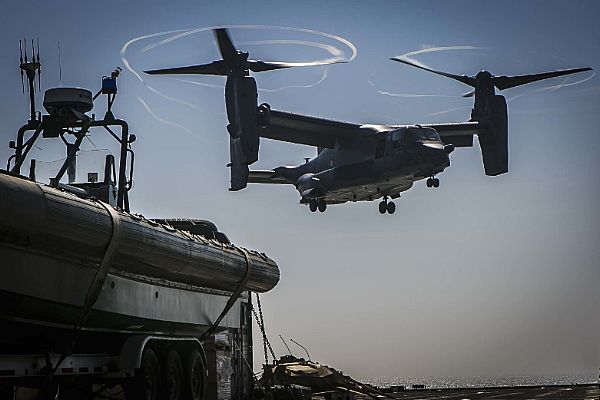
BALTIC SEA (June 4, 2018) A CV-22 Osprey prepares to land aboard the amphibious dock landing ship USS Oak Hill (LSD 51) during exercise Baltic Operations (BALTOPS) 2018. (U.S. Marine Corps photo by Staff Sgt. Dengrier M. Baez/Released)

Jura The idiot
General
4200/(39+34+1+4)
is about 54 only
Bell Boeing gets USD 4.2 bn V-22 contract from NAVAIR
is about 54 only
Bell Boeing gets USD 4.2 bn V-22 contract from NAVAIR
The US Naval Air Systems Command has awarded Bell Boeing JPO a $4,2 billion contract for V-22 tiltrotor aircraft construction.
As informed, the contract provides for the manufacture and delivery of 39 CMV-22B aircraft for the US Navy, 34 MV-22B aircraft for the Marine Corps, one CV-22B for the Air Force and four MV-22B aircraft for the government of Japan.
Work is expected to be completed in November 2024, the US Department of Defense (DoD) said.
The CMV-22B is the navy’s long-range/medium-lift element of the intra-theater aerial logistics capability and it fulfills the Joint Force Maritime Component Commander (JFMCC) time-critical logistics air connector requirements by transporting personnel, mail and priority cargo from advance bases to the Seabase.
The CMV-22B Osprey is a variant of the MV-22B and is the replacement for the C-2A Greyhound for the Carrier Onboard Delivery (COD) mission. The Osprey is a tiltrotor V/STOL aircraft that can takeoff and land as a helicopter but transit as a turboprop aircraft.
CMV-22B is capable of transporting up to 6,000 pounds of cargo/personnel to a 1,150 NM range and its operations can be either shore-based, “expeditionary”, or sea-based.
Jura The idiot
General
Yesterday at 9:23 PM
" ... for modification P00008 to convert the previously awarded V-22 tiltrotor aircraft advance acquisition contract (N00019-17-C-0015) to a fixed-price-incentive-fee multiyear contract."
I don't know what exactly this means, but sounds like piecewise funding LOL
anyway:
Navy Buys First V-22 CODs as Part of $4.2B Award to Bell-Boeing
now see the money is4200/(39+34+1+4)
is about 54 only
Bell Boeing gets USD 4.2 bn V-22 contract from NAVAIR
" ... for modification P00008 to convert the previously awarded V-22 tiltrotor aircraft advance acquisition contract (N00019-17-C-0015) to a fixed-price-incentive-fee multiyear contract."
I don't know what exactly this means, but sounds like piecewise funding LOL
anyway:
Navy Buys First V-22 CODs as Part of $4.2B Award to Bell-Boeing
The U.S. Navy bought its first CMV-22 Ospreys for use as carrier onboard delivery aircraft as part of a $4.2 billion contract modification announced by the Pentagon last week.
Under the terms of the modification, Bell-Boeing will build and deliver the first 39 CMV-22B Osprey tiltrotor aircraft for the Navy; 34 MV-22B aircraft for the Marine Corps; one CV-22B for the Air Force; and 4 MV-22B aircraft for the government of Japan, according to the announcement.
For the Navy, these are the first Osprey’s purchased specifically to replace its fleet of 27C-2A Greyhound turbo-prop aircraft. Since the 1960s, the C-2s have served as the Navy’s COD vehicle. The Navy replacement in 2015.
The current modification follows a 2016 $151 million contract awarded to Bell-Boeing to complete the engineering work needed to adapt the V-22 to operate as the COD. Those modifications included an extended-range fuel tank and a high-frequency beyond-line-of-sight radio.
The Navy anticipates the Osprey COD program achieving initial operating capability in 2021, and fielding them to the fleet by the mid-2020s. In less than a decade, supplies, mail, aircraft engines and visitors will no longer experience the explosive sensation of being on a roller coaster in reverse as the Greyhound’s tailhook catches an arresting wire. Instead, the relatively delicate landing of an Osprey tiltrotor aircraft touching down on a pitching flight deck will become the norm. Introduction of the Osprey will also change how the carrier strike group uses the COD.
“With the incorporation of the V-22, I think the fleet will also see additional capabilities from the entire group at-large, because we now have the option of taking cargo and personnel to some of the smaller decks without first having to come to the aircraft carrier,” Marine Corps Lt. Col. Brett Hart, then-Marine Operational Test and Evaluation Squadron (VMX) 1 executive officer, said in 2016 Navy. “With that considered, the carrier can expect to have potentially more flight deck and airspace freed up, allowing it to launch more sorties in support of combat operations.”
The following is the full text of the Department of Defense contract announcement:
Bell Boeing JPO, Amarillo, Texas, is awarded $4,191,533,822 for modification P00008 to convert the previously awarded V-22 tiltrotor aircraft advance acquisition contract (N00019-17-C-0015) to a fixed-price-incentive-fee multiyear contract. This contract provides for the manufacture and delivery of 39 CMV-22B aircraft for the Navy; 34 MV-22B aircraft for the Marine Corps; 1 CV-22B for the Air Force; and 4 MV-22B aircraft for the government of Japan. Work will be performed in: Fort Worth, Texas (30.08 percent); Ridley Park, Pennsylvania (15.22 percent); Amarillo, Texas (12.73 percent); Red Oak, Texas (3.33 percent); East Aurora, New York (2.55 percent); Park City, Utah (2.20 percent); McKinney, Texas (1.33 percent); Endicott, New York (1.15 percent); Denton, Texas (0.91 percent); Rockmart, Georgia (0.80 percent); Irvine, California (0.78 percent); Rome, New York (0.76 percent); Crestview, Florida (0.72 percent); Erie, Pennsylvania (0.66 percent); Dublin, California (0.62 percent); Rockford, Illinois (0.62 percent); Tempe, Arizona (0.57 percent); Los Angeles, California (0.57 percent); East Hartford, Connecticut (0.55 percent); Minden, Nebraska (0.50 percent); Hazelwood, Missouri (0.50 percent); and various other locations within the continental U.S. (18.93 percent); and outside the continental U.S. (3.92 percent), and is expected to be completed in November 2024. Fiscal 2017 aircraft procurement (Navy, Air Force, and Marine Corps); and fiscal 2018 aircraft procurement (Navy) funding in the amount of $1,113,956,972 will be obligated at time of award, none of which will expire at the end of the current fiscal year. This modification combines purchases for the Navy ($2,847,293,666; 67.9 percent); Marine Corps ($1,038,248,567; 24.8 percent); Air Force ($75,705,989; 1.8 percent); and the government of Japan ($230,285,600; 5.5 percent), under the Foreign Military Sales program. The Naval Air Systems Command, Patuxent River, Maryland, is the contracting activity.
Jura The idiot
General
now noticed a moderately interesting tweet
GEORGE H W CVN77 off the US East Coast last week operating MV-22 from HX21 and T-45C from Training Air Wing 1.
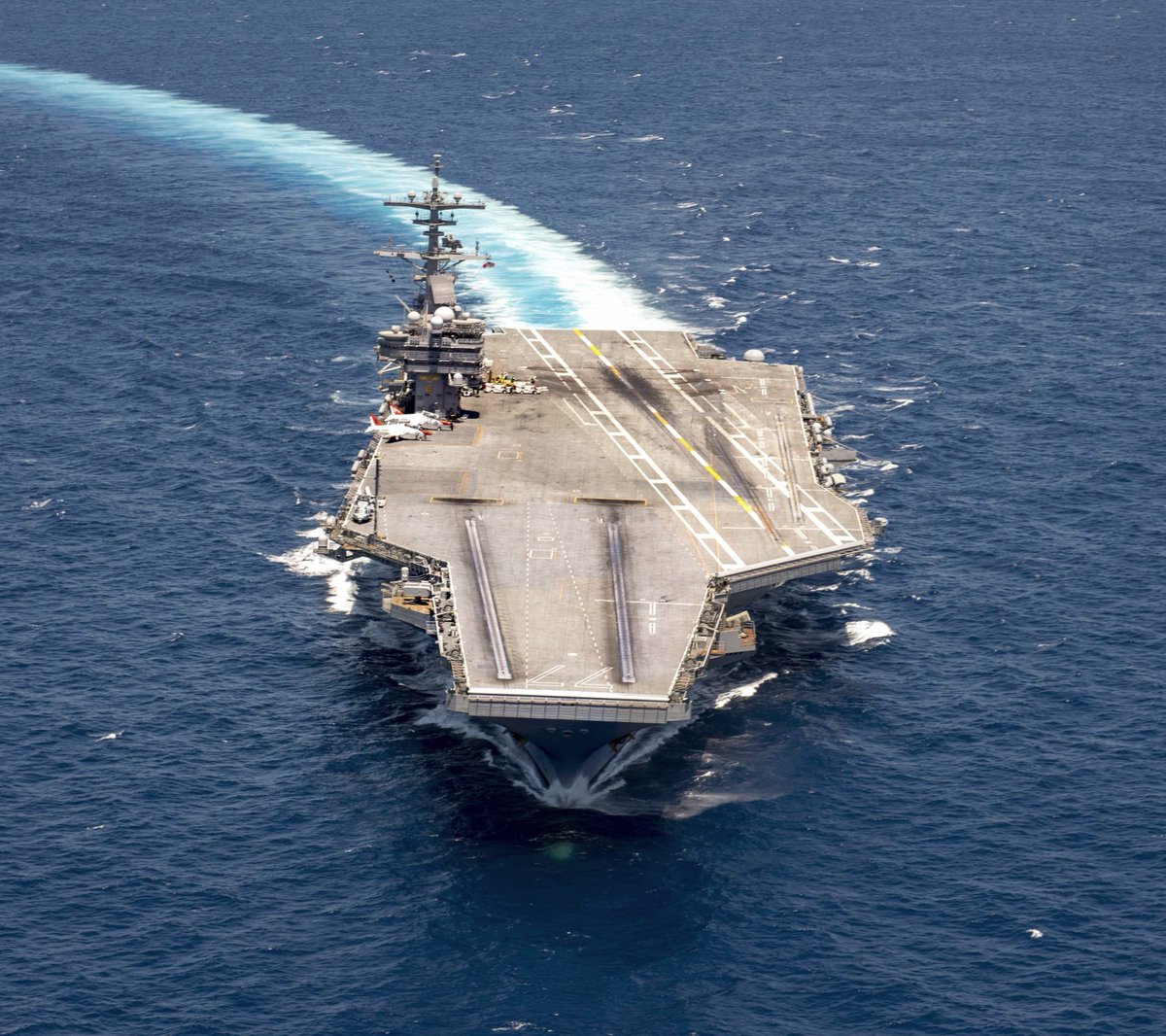
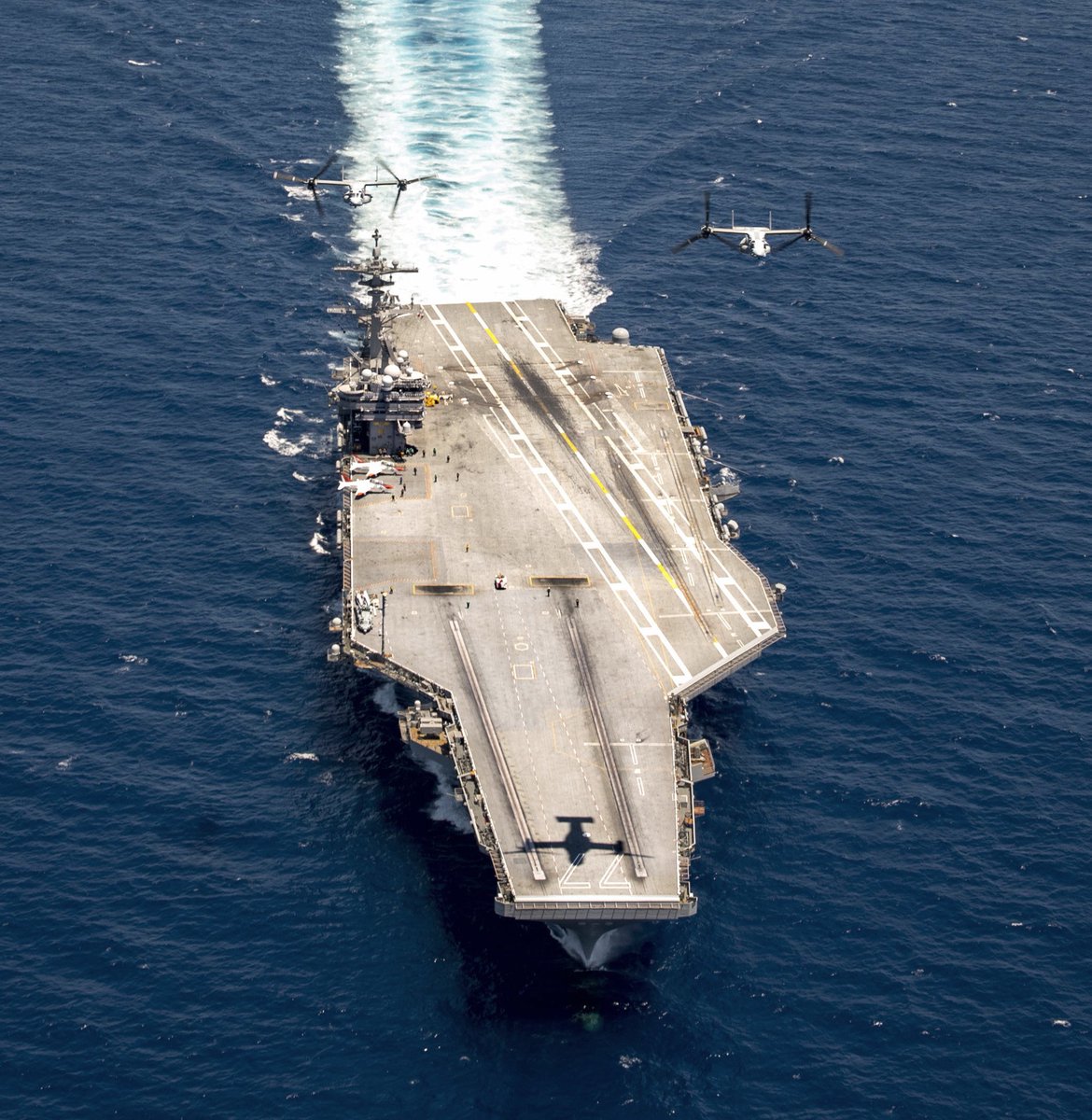
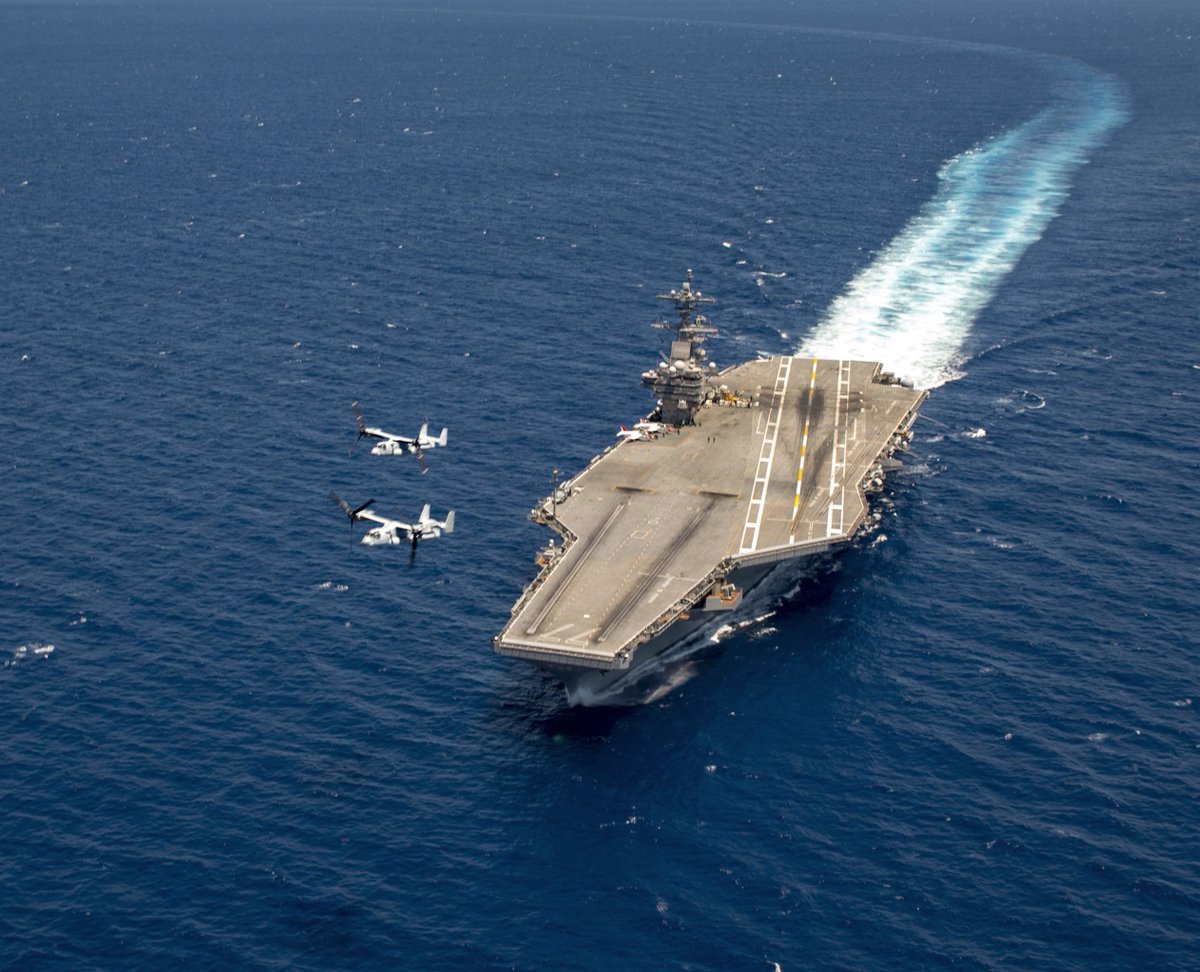
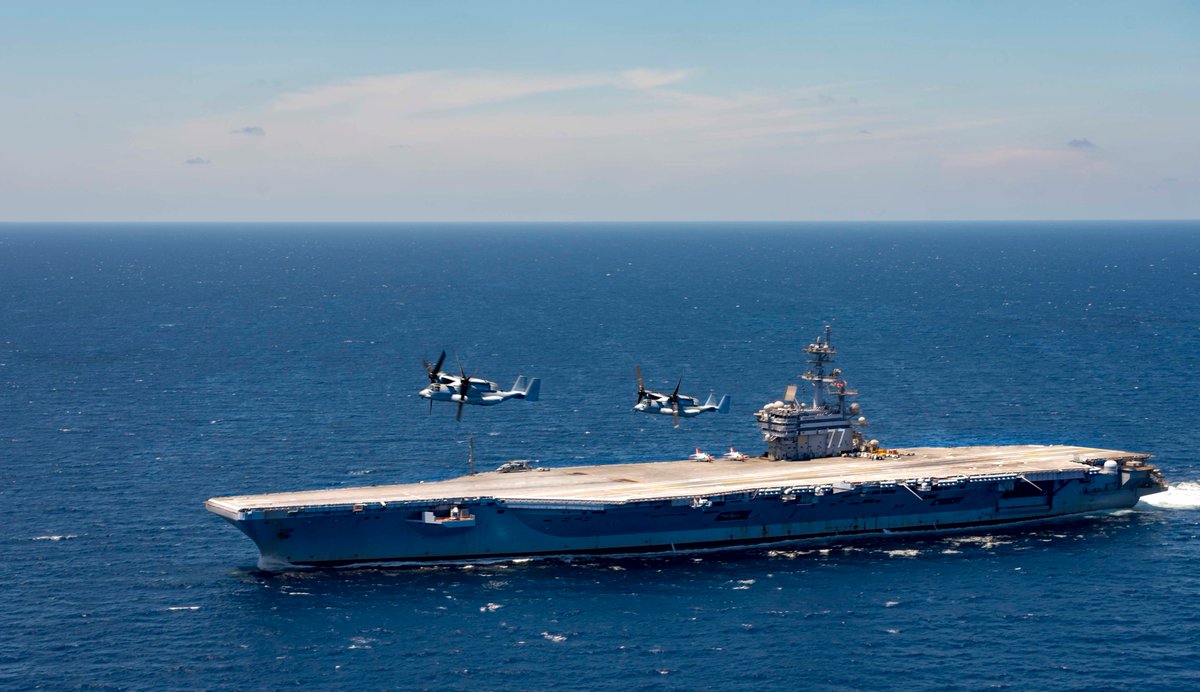
GEORGE H W CVN77 off the US East Coast last week operating MV-22 from HX21 and T-45C from Training Air Wing 1.




Jura The idiot
General
LOL recall I naysayed F-35 engine deliveries by Ospreys ... Jan 7, 2018
Navy Set to Establish First CMV-22B COD Squadron at NAS North Island

now...
another thing is the declared need of an Osprey for transporting an F-35 engine: it probably is just a spin, as ones F-35s become truly operational (I don't mean public stunts with a ship full of contractors), a decade or decades from now, only squared away machines (not the LRIP stuff) will be taken on board as ALIS may even work by then
OK and if an engine got damaged anyway, they'd just leave that aircraft in a hangar (again, in real world situations, not with journalists around)
...
Navy Set to Establish First CMV-22B COD Squadron at NAS North Island
and inside is this graphics:The chief of naval operations has set a date for the establishment of a new carrier-onboard-delivery (COD) squadron that will be the Navy’s first squadron to operate the new CMV-22B Osprey tiltrotor transport aircraft. A CMV-22B training group also will be established.
Fleet Logistics Multi-Mission Squadron 30 (VRM-30) will be established at Naval Air Station (NAS) North Island, California, on Oct. 1, according to an internal Navy directive. When equipped with CMV-22Bs, VRM-30 will deploy detachments of CVM-22Bs with each carrier air wing from the West Coast and Japan, succeeding the C-2A Greyhound COD aircraft of Fleet Logistics Support Squadron 30 (VRC-30).
To support the Navy’s transition from the C-2A to the CMV-22B, the Naval Aviation Training Support Group (NATSG) will established the same date at Marine Corps Air Station New River, North Carolina, where the Marine Corps’ V-22 fleet replacement squadron, Marine Medium Tiltrotor Training Squadron 204 (VMMT-204) is based. The NATSG will “liaise with the United States Marine Corps, and oversee United States Navy pilot, aircrew, and aircraft maintenance personnel through the training pipeline at VMMT-204,” the directive said.
Currently a detachment of Commander, Airborne Command & Control and Logistics Wing, the type wing for the two VRC squadrons as well as the E-2D squadrons, supervises the Navy’s V-22 training at New River.
Eventually, a new type wing will be established at North Island as the reporting command for the two planned VRM squadrons, VRM-30 and VRM-40, the latter squadron being planned to replace VRC-40, the C-2A squadron based at Norfolk, Virginia.
Also, a third squadron VRM-50, eventually will be established at North Island as the fleet replacement squadron for the CMV-22B community when the training shifts from New River.

